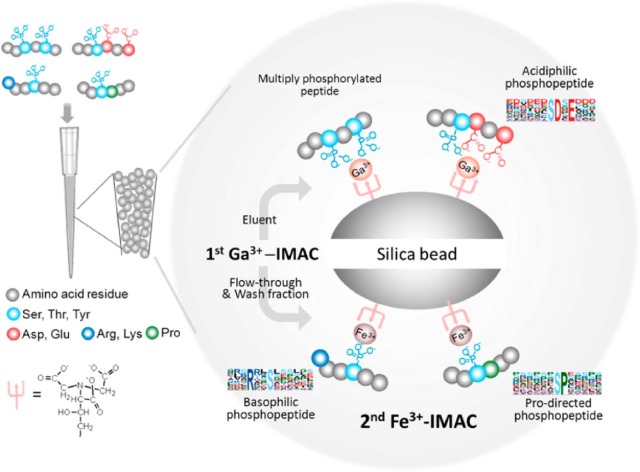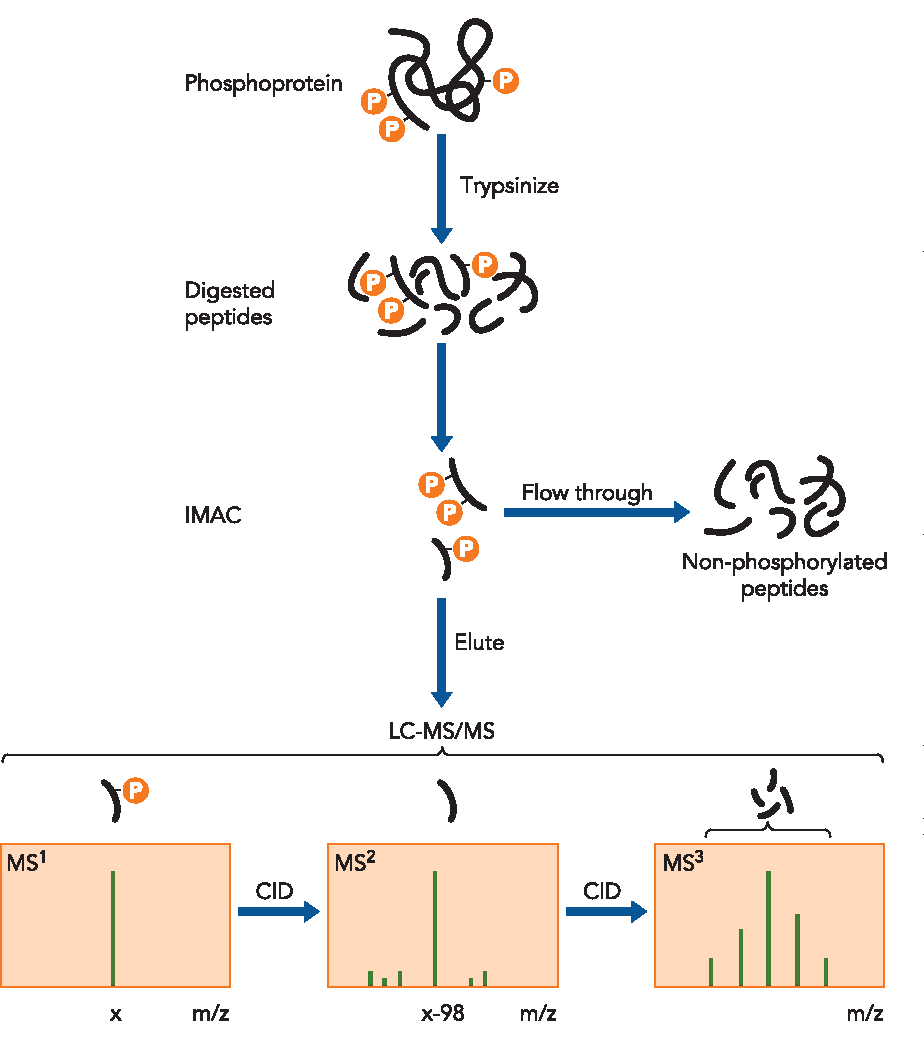Phosphopeptide Enrichment Followed by Mass Spectrometry (TiO₂/IMAC) Service
- TiO₂ provides high selectivity for monophosphorylated peptides, making it particularly effective for enriching Ser/Thr phosphorylation events. However, it may exhibit non-specific binding to certain acidic peptides.
- IMAC, relying on trivalent metal ions (e.g., Fe³⁺, Ga³⁺), is better suited for multiphosphorylated peptides, though it may capture negatively charged non-phosphorylated peptides.
- High-resolution MS with HCD and ETD fragmentation to maximize sequence coverage.
- PhosphoRS-based probability scoring to enhance phosphorylation site localization accuracy.
- Stringent false discovery rate (FDR) control and multi-database cross-validation to ensure robust and biologically meaningful results.
Phosphopeptide Enrichment Followed by Mass Spectrometry (TiO₂/IMAC) Service is designed to enhance the sensitivity and coverage of phosphoproteomics research by implementing highly selective phosphopeptide enrichment strategies. Phosphorylation is a critical post-translational modification (PTM) that plays a pivotal role in cellular signaling, metabolic regulation, cell cycle control, and disease progression. However, due to its dynamic nature and low abundance, direct phosphopeptide detection via mass spectrometry (MS) often encounters limitations in sensitivity and interference from background signals. Therefore, selective phosphopeptide enrichment before MS analysis is a crucial step in phosphoproteomics.
At MtoZ Biolabs, our Phosphopeptide Enrichment Followed by Mass Spectrometry (TiO₂/IMAC) Service utilizes Titanium Dioxide (TiO₂) and Immobilized Metal Affinity Chromatography (IMAC) for efficient and specific phosphopeptide enrichment, enabling precise phosphoproteomic profiling with high-resolution mass spectrometry.
Technical Principles
Efficient phosphopeptide enrichment is crucial for enhancing the sensitivity and specificity of MS detection. Our Phosphopeptide Enrichment Followed by Mass Spectrometry (TiO₂/IMAC) Service employs TiO₂ and IMAC, which utilize the strong affinity of phosphate groups for metals or metal oxides, ensuring selective phosphopeptide isolation.
· TiO₂ Enrichment: Based on Lewis acid-base interactions, TiO₂ selectively binds phosphopeptides under acidic conditions, offering high specificity, particularly for detecting low-abundance phosphorylation events.
· IMAC Enrichment: Utilizing immobilized trivalent metal ions (e.g., Fe³⁺, Ga³⁺), IMAC provides high enrichment efficiency, making it ideal for large-scale phosphoproteomics studies.

Li, X. S. et al. TRAC-TREND ANAL CHEM. 2016.
Figure 1. IMAC Strategy for Phosphopeptide Enrichment
The addition of a phosphate group (H₃PO₄, ~79.98 Da) results in an increase in peptide molecular weight and alters charge distribution. High-resolution mass spectrometry (e.g., Orbitrap, FTICR-MS) precisely detects these mass shifts, while tandem MS (MS/MS) allows for accurate phosphorylation site localization. Data-dependent acquisition (DDA) and data-independent acquisition (DIA) strategies further improve phosphoproteome coverage and quantification accuracy. By integrating results with expert-curated databases (e.g., UniProt, PhosphoSitePlus), we facilitate in-depth functional analysis of phosphorylation events.
Analysis Workflow
MtoZ Biolabs offers a comprehensive Phosphopeptide Enrichment Followed by Mass Spectrometry (TiO₂/IMAC) Service that covers the entire workflow from sample preparation to high-resolution MS detection and data analysis.
1. Sample Processing & Protein Digestion
Optimized protein extraction and enzymatic digestion protocols ensure efficient peptide generation.
2. Phosphopeptide Enrichment
TiO₂ and IMAC methods, combined with refined elution strategies, enhance enrichment efficiency and specificity.
3. High-Resolution MS Detection
Advanced Orbitrap or Q-TOF MS platforms ensure high-sensitivity phosphopeptide detection.
4. Bioinformatics Analysis
Comprehensive analysis, including quantitative profiling, phosphorylation site identification, and pathway enrichment analysis, enables deep biological insights.

Pisitkun, T. et al. J. Physiol. 2007.
Why Choose MtoZ Biolabs?
1. Dual Enrichment Strategy for Enhanced Specificity: The integration of TiO₂ and IMAC provides complementary enrichment, improving specificity and phosphopeptide recovery rates.
2. High-Sensitivity MS Detection: Advanced Orbitrap MS platforms facilitate precise detection of low-abundance phosphopeptides.
3. Optimized Elution & Data Processing: Cutting-edge elution strategies and computational algorithms improve site localization confidence.
4. Robust Quantitative Analysis: Integration of TMT/iTRAQ labeling strategies supports high-throughput phosphoprotein quantification.
5. One-Time-Charge: Our pricing is transparent, no hidden fees or additional costs.
Applications
Our Phosphopeptide Enrichment Followed by Mass Spectrometry (TiO₂/IMAC) Service enables in-depth phosphoproteomic studies across various research fields, providing critical insights into phosphorylation-mediated biological processes.
· Cell Signaling Pathway Studies: Investigate phosphorylation dynamics in signaling networks to identify regulatory proteins.
· Disease Biomarker Discovery: Identify disease-associated phosphorylated proteins as potential diagnostic and therapeutic targets.
· Drug Mechanism Studies: Assess the effects of drug candidates on phosphorylation-mediated signaling pathways.
· Cancer Research: Explore aberrant phosphorylation events in tumor cells to uncover key drivers of oncogenesis.
· Immunology Research: Examine phosphorylation-dependent immune activation mechanisms for vaccine and immunotherapy development.
FAQ
Q1: How to choose between TiO₂ and IMAC enrichment strategies?
Both TiO₂ and IMAC have distinct advantages:
In general, TiO₂ is optimal for monophosphorylated peptide detection, while IMAC is preferred for multiphosphorylated peptide analysis. MtoZ Biolabs employs a hybrid enrichment strategy, ensuring optimal phosphopeptide recovery, improved data integrity, and high specificity.
Q2: How to enhance the detection sensitivity of low-abundance phosphopeptides?
Low-abundance phosphopeptides often suffer from signal suppression due to background interference. MtoZ Biolabs implements an optimized sample preparation workflow, integrating TiO₂/IMAC dual enrichment to maximize phosphopeptide recovery. Additionally, we utilize high-resolution Orbitrap MS platforms, combined with DIA-based quantification or TMT/iTRAQ labeling strategies, to enhance sensitivity and enable accurate detection of low-abundance phosphorylation modifications.
Q3: How does MtoZ Biolabs ensure high-confidence phosphorylation site identification?
To achieve high-confidence site localization, MtoZ Biolabs integrates:
Our Phosphopeptide Enrichment Followed by Mass Spectrometry (TiO₂/IMAC) Service Analysis Service provides high-quality data support, advancing your scientific research and applications. For any inquiries or requirements, please contact us.
MtoZ Biolabs, an integrated chromatography and mass spectrometry (MS) services provider.
Related Services
Quantitative Phosphoproteomics Service
How to order?







